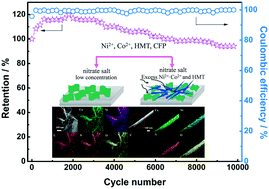Hierarchical nickel and cobalt inorganic–organic nanostructures on carbon fiber paper have been fabricated by a one-step hydrothermal approach directed by hexamethylenetetramine (HMT). The morphology and evolution of these single-crystalline inorganic–organic nanosheets–nanowires (IOSW) are investigated. Results show that HMT plays a vital role in the secondary growth of single-crystalline nanowires. Besides, HMT molecules intercalate within the interlayers of inorganic materials, forming single-crystalline organo-LDH (layered double hydroxide) nanosheets and organo-carbonate hydroxide nanowires. Furthermore, the electrode is employed for battery-like energy storage applications. The interconnected nanosheet–nanowire structure affords rich open spaces and efficient passways for ion diffusion and electron transport. A specific capacitance of 1308 F g−1 (1.7 F cm−2, at the current density of 4 mA cm−2) and excellent long-term cycling performance (94% retention after 10 000 cycles) are achieved. The high stability of the electrode could be attributed to the interactions between HMT and nickel/cobalt within the interlayer. In addition, a two-electrode device consisting of nickel and cobalt IOSW as the positive electrode and commercial active carbon as the negative electrode is fabricated and reaches a maximum energy density of 32.3 W h kg−1 (8 A g−1).
